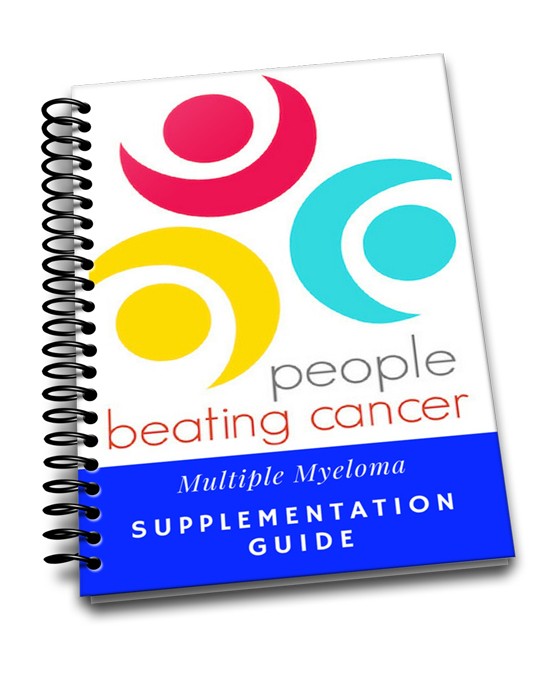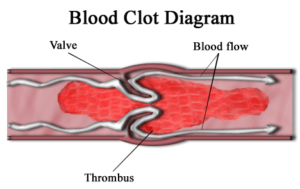
Recently Diagnosed or Relapsed? Stop Looking For a Miracle Cure, and Use Evidence-Based Therapies To Enhance Your Treatment and Prolong Your Remission
Multiple Myeloma an incurable disease, but I have spent the last 25 years in remission using a blend of conventional oncology and evidence-based nutrition, supplementation, and lifestyle therapies from peer-reviewed studies that your oncologist probably hasn't told you about.
Click the orange button to the right to learn more about what you can start doing today.
- You are here:
- Home »
- Blog »
- Multiple Myeloma »
- Blood Clot as Symptom of Multiple Myeloma
Blood Clot as Symptom of Multiple Myeloma

“Multiple myeloma (MM) has one of the highest risks of thrombosis (symptom) among all cancers due to disease-related pathological changes…
A blood clot (DVT) can be either a symptom of MM, or a serious side effect of chemotherapy. MM chemotherapies such as thalidomide and revlimid can cause thrombosis/blood clots in MMers as well. The bottom line is that MMers are at a real risk of blood clots. So what’s a MMer to do?
 I’m not an oncologist. I’m just a MM survivor who developed two blood clots at different times, one in each leg. My oncologist prescribed warfarin and heparin. But those therapies didn’t really work. And they each come with side effects and health risks themselves.
I’m not an oncologist. I’m just a MM survivor who developed two blood clots at different times, one in each leg. My oncologist prescribed warfarin and heparin. But those therapies didn’t really work. And they each come with side effects and health risks themselves.
My point is that conventional oncology, according to my experience and the two articles linked and excerpted below, doesn’t really understand DVT’s aka blood clot as a symptom of MM, at least when it comes to managing multiple myeloma long-term.
I understand that self-diagnosis and treatment comes with risks. But I tried conventional oncology and came away with problems that, in my mind, weren’t any better than that where I started. I now live with post-thrombotic syndrome. My only treatment option now is surgery. No thank you. The cure was every bit as bad as the disease.
Enzymes, nattokinase, omega-3 fatty acids, diet, exercise and other therapies have managed my blood clots as well as atrial fibrillation (a side effect of cardio-toxic chemotherapy) since my original blood clots in ’95-’97.
Do you have multiple myeloma? Do you have a DVT, blood clot? To learn more about evidence-based, non-toxic blood clot therapies scroll down the page, post a question or comment and I will reply to you ASAP.
thank you,
David Emerson
- MM Survivor
- MM Cancer Coach
- Director PeopleBeatingCancer
Recommended Reading:
- Post-thrombotic Syndrome- Causes,Therapies
- Reduce/Eliminate Blood Clots (DVT) from Chemotherapy
- Post Thrombotic Syndrome Therapies-Natural Blood Thinners
What if Google or Amazon Designed Clinical Trials?
“Yes, we’re going to examine the CASSINI and AVERT trials, both of which evaluated whether oral anticoagulants would prevent venous thrombosis in high-risk patients with cancer.[1,2]…
Let’s start at the beginning. Individuals with cancer are at risk of developing blood clots, but prevention requires the use of blood-thinning medications, which themselves carry substantial risk. Physicians and patients are not always great at balancing risks and benefits, so it would really help if we had strong data to guide us…
Nevertheless, it was the hope of the CASSINI and AVERT trials to target individuals with a high risk for blood clot based on the validated Khorana score, which takes into account the type of cancer and a variety of lab parameters, in order that the overall effect would be compelling enough to lead us to a new standard of care…
So, what did they find? Nothing to settle the debate, I’m afraid. CASSINI randomized 841 patients to rivaroxaban (Xarelto) 10 mg daily…
The rate of blood clot was 8.8% in the placebo group and 6% in the intervention group, a nonsignificant reduction with a number needed to treat of 36. AVERT randomized 563 patients to apixaban (Eliquis) 2.5 mg twice daily. The rate of blood clot was 10.2% in the placebo group and 4.2% in the intervention group, a number needed to treat of 17.
It may seem that apixaban won this contest, but remember that these are two separate trials, not a head-to-head comparison…
But don’t go rushing to the prescription pad yet. The overall death rate was 12.2% in the apixaban group compared with 9.8% in the control group.
That’s right: fewer clots, more deaths. Not great…
Until we move to a smarter type of clinical trial enrichment, we’re going to remain frustrated at how hard it is to figure out just who is a good candidate for a risky therapy. Those at highest risk, counterintuitively, may be exactly the wrong ones to target.”
Incidence and Risk Factors of Thromboembolism with Multiple Myeloma in the Presence of Death as a Competing Risk: An Empirical Comparison of Statistical Methodologies
“Multiple myeloma (MM) has an inherent high risk of thromboembolic events associated with patient as well as disease- and treatment-related factors…
Compared to the general population, individuals with cancer are at 4 to 7 times higher risk of developing a venous thromboembolism (VTE) [1,2,3,4]. Malignancy induces a prothrombotic state which includes activation of the coagulation cascade, increase in pro-inflammatory cytokines, as well as inhibition of natural anticoagulants and is further exacerbated by cancer treatment and surgery [5,6,7].
Although at an already increased risk of death from cancer, VTE carries a substantial risk of mortality with clotting events accounting for up to 10% of all deaths in patients with cancer [11,12,13].
Multiple myeloma (MM) has one of the highest risks of thrombosis among all cancers due to disease-related pathological changes and treatment [7,14]. Thalidomide and lenalidomide (IMIDs) are well known to be associated with increased risk of thrombosis [15], especially when combined with high-dose steroids and other chemotherapy, with incidence approaching 25% in some studies…
Despite the known risk, the pathogenesis of thrombosis in MM is poorly understood due to the various factors that can impart risk including patient characteristics, disease-related factors, as well as treatment-related risks [7]. Although thrombotic events have not been shown to have a large impact on overall survival specifically in MM [36], thrombosis events can cause interruption in therapy as well as tremendous economic and humanistic burdens in the MM population [38,39]…
7 Diet Tips to Help Prevent Deep Vein Thrombosis
“1) Drink Up to Keep Blood Flowing Smoothly
Dehydration can cause your blood to thicken, increasing your risk for a blood clot. To stay well-hydrated, women should consume an average of 91 ounces (oz) of water from all beverages and food daily, and men an average of 125 oz, according to the National Academy of Sciences, Engineering and Medicine guidelines.
One way to gauge if you’re on track is to check your urine. If it is a pale yellow color or clear, you are probably drinking enough, according to the Cleveland Clinic. If it’s amber-colored or darker, you’re probably not and should increase your daily water intake.
2) Sip Grape Juice or Red Wine to Make Platelets Less Sticky
Drinking moderate amounts of red wine or purple grape juice daily helps keep blood platelets from sticking together and forming clots, thanks to powerful antioxidants called polyphenols in purple grapes, suggested a review of previous studies, published in The Journal of Nutrition.
3) Flavor Food With Garlic to Stop Trouble Before It Starts
Garlic is thought to have many health benefits, including possibly breaking up potentially harmful clusters of platelets in the bloodstream, according to research published in the Journal of Agricultural and Food Chemistry. The best way to reap that benefit from garlic, the research shows, is to crush the raw cloves to release their beneficial compounds, then eat them raw, oven-roasted, or boiled for three minutes or less.
4) Avoid Unhealthy Fats to Avoid Slowing Circulation
The same foods that in excess can cause plaque buildup in blood vessels, increasing the risk of heart disease, can also increase the risk of developing DVT, Dr. Masley notes. That means you want to stay away completely from unhealthy trans fats and cut way back on the saturated fats in full-fat dairy and fatty cuts of red meat, as well as sugar and salt, according to the American Heart Association. “These are all foods that increase inflammation,” Masley explains…
5) Use Virgin Olive Oil to Cut Your Blood Clot Risk
Similarly, an earlier study published in the American Journal of Clinical Nutrition found that antioxidants called phenols in virgin olive oil helped prevent blood clots. In the study, people who consumed virgin olive oil with a high phenol content had lower levels of a substance that promotes blood clots…
6) Make Leafy Greens a Routine
Leafy greens contain vitamin K2. Vitamin K2 inhibits multiple myeloma.
7) Limit Animal Fats in Your Diet
Finally, Masley says that the same foods that are bad for cardiovascular health in general can also increase your risk of developing blood clots. That means you want to stay away from unhealthy trans fats, from the saturated fats in full-fat dairy and fatty meats, and from all types of sugar. “These are all foods that increase inflammation,”

